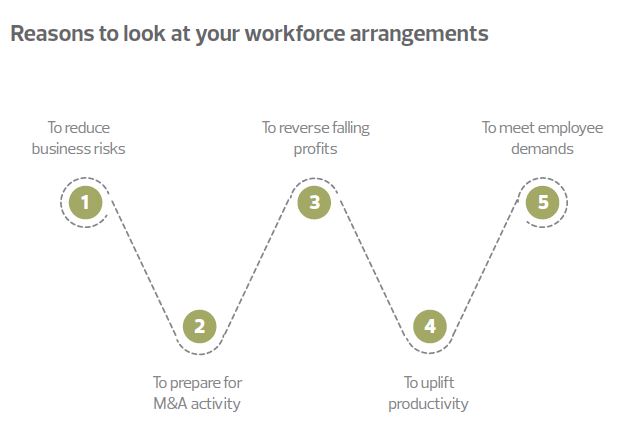If you were to set up your organisation tomorrow, would you keep the same workforce arrangements you have today?
Many business structures evolve organically. Others have been guided by what was once the most tax efficient option.
That means that the mix of workers and contracts you have in place may no longer be right for your business – or your workforce.
Demand for flexible employment arrangements has soared over the past decade. Alongside your full-time employees, you must now manage an ever-growing list of contractors and self-employed personnel. It’s critical you get this right. One wrong step could expose you to significant financial, legal and reputational risks.
The way a person is labelled and operates at work has a big impact on the way they’re taxed and the legal rights they can claim. You must make sure your people’s contracts truly reflect their daily realities. If they don’t, you could face legal claims, WRC investigations and criticism that you’re not meeting your moral obligations. Make sure you’re moving with the times.

Work status: why does it matter?
The way someone is categorised at work has a huge impact on their working rights, the way they are taxed and an organisation’s obligations to them.

Get your workforce contracts right
Amid growing media and public scrutiny, you must take steps to make sure everyone at your organisation is on a contract that truly reflects the reality of what they do each day.
1. Align your business and workforce strategies
Before you can decide whether your workforce structure is fit for purpose, you need to think about what your organisation is trying to achieve. Look at your business strategy. Will your organisation only realise its aims if everyone works five days a week for every month of the year? Or could you still reach your goals if you introduced more flexible arrangements, such as adjusting your workforce numbers in line with the seasons or project pipelines? Forecast all scenarios, and then develop a workforce strategy that will support your wider business goals.
2. Set the right tone at the top
Changing your workforce structure is a time-intensive exercise. It takes commitment to do it well. Make sure your executive team and board recognise the importance of getting it right. A useful first step is to include your workforce structure on your risk register. This will help everyone at the top of your organisation understand how the wrong arrangements could undermine your operations and future profitability. It will also ensure the proper time and financial resources are set aside to review your structure and to make any necessary updates.
3. Review your engagement terms
It makes good business sense to check the engagement terms of everyone who’s working at your organisation. This will help you address documentation gaps before problems arise and allow you to work out if you have the correct arrangements in place. Your employment contracts are a good place to start. But you’ll also need to review the terms included in other written records, such as engagement letters and documents, staff handbooks, union agreements, share plans, bonus letters and legacy contracts for staff joining through business structure change. Take the time to find all document sources – even email exchanges and verbal deals can amount to contractual terms of employment.
4. Check your people’s daily work realities
Once you have a clear picture of a person’s engagement terms, you need to check whether these reflect the reality of their working life. Set aside time with their line managers. Ask them about each team member’s arrangements, such as their job title, what they do each day, who they report to and how, when and where they work. This is a time-intensive and detailed process. You’ll need to invest in legal and tax advice – either internally or externally – to reach the correct judgements about which contractual category your people fall into. If you get it wrong, you run the risk of exposing your organisation to legal claims and HMRC investigations.
5. Manage change in the right way
In today’s fast-changing world, workforce demands and business needs can quickly evolve. If you find a person’s contract no longer reflects their daily reality, you have two options: update their contractual arrangements or update their working practices. You need dynamic contracts to support change. You must tread carefully. If you make change in the wrong way or fail to tackle the problem, you could end up in front of the WRC. Make sure you engage with individuals before updating their arrangements. And remember, if you’re changing someone’s contract you may have to give them extra financial reward to make the alterations valid and binding. If you’ve inherited staff through business change, you may face extra barriers to alter their terms. Seek legal advice before altering their arrangements.
You can download the full toolkit here

